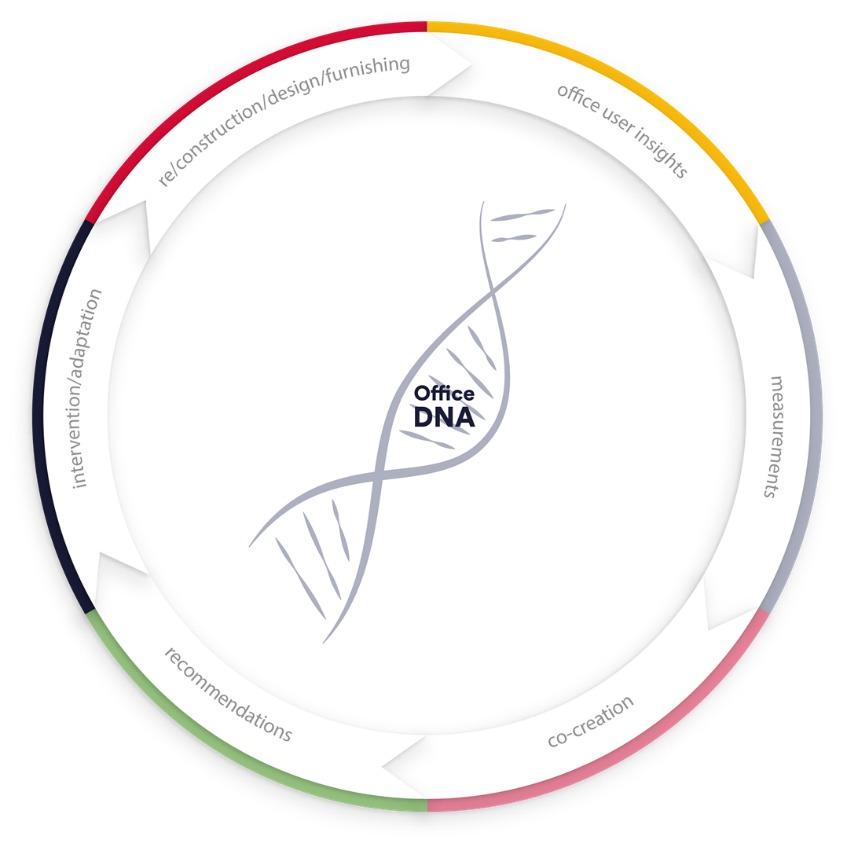Reveal your office-DNA to increase productivity and reduce environmental impacts
Holger Wallbaum

We are living in a globalised world that is characterised by a continuing trend of urbanisation. First time in history, more than half of the world population is living in urbanized areas. (http://www.un.org/en/development/desa/population/publications/pdf/urbanization/the_worlds_cities_in_2016_data_booklet.pdf) and almost three quarters of the European population lived in an urban area in 2015.
This development has enormous social, economic as well as environmental consequences, e.g. that real estate prices are steadily going up since the demand outweighs the available land for construction purposes often by several magnitudes (https://ec.europa.eu/eurostat/statistics-explained/index.php?title=Urban_Europe_%E2%80%94_statistics_on_cities,_towns_and_suburbs, chapter 2). This price increase is even further triggered by the fact that interest rates are low, and capital is looking for other investment opportunities, which is very often the real estate market.
Hence, the rents – and not only for prime site properties - went up steeply in the last years, especially for office buildings that tenants have a strong economic incentive to reduce office space as much as possible to bring operational costs down. Consequently, cell offices (CO) have been replaced by open-plan offices (OPO) with a much better ratio of office space per employee. This development has spread all over the world and is the most common type of office today.
Unfortunately, it is often neglected that there is an obvious downside that goes along with this type of office, namely, increased stress level and days of absence of employees, higher staff fluctuation due to an unsupportive work environment and finally a reduced productivity. Considering that staff costs often count for 90% of the operational costs in service-oriented businesses (see Fig. 1), this development is in diametral contradiction to the intended purpose of reducing office space – explicitly, to reduce operational costs.
Fig. 1 Staff cost variations do really make a difference (World Green Building Council (2014) - Health, Wellbeing & Productivity in Offices).
These downsides have become a repeatedly addressed topic in media, and researchers from all over the world have started publishing about work environment related effects of open plan offices that a new wave of office type has been introduced – the activity-based offices (ABO). These ABOs should support the employees ideally by specifically designed spaces for different working activities, such as focussed work, meetings with colleagues, creative sessions with clients etc. Putting the working activities into the center of architecture and workspace design is certainly a step in the right direction but is still not sufficient. The introduction of the WELL certification scheme is another indication that the office market is slowly about to change (https://v2.wellcertified.com/).
We at Furbish (www.furbish.se) have gone a large step further with the introduction of our approach to reveal the specific Office-DNA of each organization and give the employees demands and their productivity the highest priority.
Fig. 2 An evidenced based circular approach to reveal employees needs and assure an advantageous and long-term organisational development (FurbishTM).
By help of deep user involvement through e.g. questionnaires, a diary study that runs on a smart phone app (Fig. 3), observations, deep interviews and measurements on e.g. the Indoor Environmental Quality (IEQ) and energy performance in an existing working environment, do we get the insights that are needed to plan and design new or renovate existing office environments who are setting a new benchmark and the highest standard for the employee’s well-being and productivity (see CIB W098 research roadmap on Intelligent and Responsive Buildings, https://site.cibworld.nl/dl/publications/CIB_415_W098_RR.pdf).
Fig. 3 : Our smart phone supported Furbish diary-app helps us to understand your working activities (FurbishTM).
Our unique database and the science-based and validated approach allow our clients, typically real estate owners, architectural offices or the tenants themselves to develop a better understanding of the work environment related spaces that really fit their demands. Our clear recommendations do not exclude types of offices – in contrast, everything is allowed if it fits the organization's demand and the employee's needs. With the Furbish approach, we go beyond energy efficiency to bring down your operational costs while increasing the satisfaction of your employees.
Additional information:
https://www.youtube.com/watch?v=Aa9zS_s4G-8



